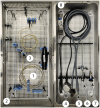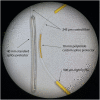Iterative prototyping based on lessons learned from the falloposcope in vivo pilot study experience
- PMID: 37577082
- PMCID: PMC10423010
- DOI: 10.1117/1.JBO.28.12.121206
Iterative prototyping based on lessons learned from the falloposcope in vivo pilot study experience
Abstract
Significance: High grade serous ovarian cancer is the most deadly gynecological cancer, and it is now believed that most cases originate in the fallopian tubes (FTs). Early detection of ovarian cancer could double the 5-year survival rate compared with late-stage diagnosis. Autofluorescence imaging can detect serous-origin precancerous and cancerous lesions in ex vivo FT and ovaries with good sensitivity and specificity. Multispectral fluorescence imaging (MFI) can differentiate healthy, benign, and malignant ovarian and FT tissues. Optical coherence tomography (OCT) reveals subsurface microstructural information and can distinguish normal and cancerous structure in ovaries and FTs.
Aim: We developed an FT endoscope, the falloposcope, as a method for detecting ovarian cancer with MFI and OCT. The falloposcope clinical prototype was tested in a pilot study with 12 volunteers to date to evaluate the safety and feasibility of FT imaging prior to standard of care salpingectomy in normal-risk volunteers. In this manuscript, we describe the multiple modifications made to the falloposcope to enhance robustness, usability, and image quality based on lessons learned in the clinical setting.
Approach: The diameter falloposcope was introduced via a minimally invasive approach through a commercially available hysteroscope and introducing a catheter. A navigation video, MFI, and OCT of human FTs were obtained. Feedback from stakeholders on image quality and procedural difficulty was obtained.
Results: The falloposcope successfully obtained images in vivo. Considerable feedback was obtained, motivating iterative improvements, including accommodating the operating room environment, modifying the hysteroscope accessories, decreasing endoscope fragility and fiber breaks, optimizing software, improving fiber bundle images, decreasing gradient-index lens stray light, optimizing the proximal imaging system, and improving the illumination.
Conclusions: The initial clinical prototype falloposcope was able to image the FTs, and iterative prototyping has increased its robustness, functionality, and ease of use for future trials.
Keywords: endoscopic optical coherence tomography; fallopian tube; in vivo imaging; microendoscope iterative design and prototyping; multispectral fluorescence imaging; ovarian cancer.
© 2023 The Authors.
Figures











References
-
- American Cancer Society, “Survival rates for ovarian cancer,” 2022, https://www.cancer.org/cancer/ovarian-cancer/detection-diagnosis-staging....
Publication types
MeSH terms
LinkOut - more resources
Full Text Sources
Medical

